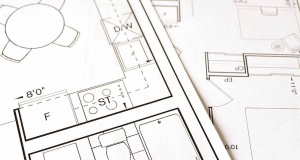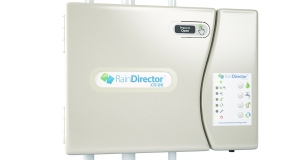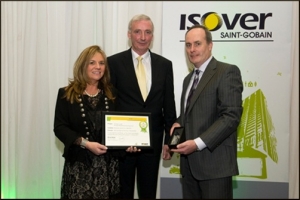 Padraig Doyle, Brian Hennelly and Don McEntee
Padraig Doyle, Brian Hennelly and Don McEntee
- Water
- Posted
SuDS

SuDS are defined by CIRIA as “a sequence of management practices and control structures designed to drain surface water in a more sustainable fashion than some conventional techniques”1. The term SuDS is used here rather than SUDS (Sustainable Urban Drainage Systems), as these techniques are as applicable to rural settings as they are to urban areas.
Using SuDS techniques, water is either infiltrated or conveyed more slowly to water courses via ponds, swales, filter drains or other installations to try and closely mimic natural catchment drainage behaviour. Run-off is frequently delayed in natural ponds or hollows. In addition to delaying the rate of runoff, there is more likelihood in the natural situation that pollutants will be filtered through soils or broken down by bacteria. By mimicking this SuDS attenuates stormwater runoff and improves environmental performance.
Stormwater Control
The need for control of stormwater runoff has long been recognised in Dublin. Rainfall on a greenfield site is either absorbed into the ground or runs off slowly to the nearest watercourse. When these sites are built on, much of the area becomes impermeable with runoff being piped to the nearest watercourse or storm drain. Thus both the volume and rate of runoff can dramatically increase, which may lead to flooding or increased overflows from combined sewers, neither of which is acceptable. This is of particular concern in Dublin, where many of the densely built up areas are at the downstream end of rivers and drainage systems and there is increased pressure to allow upstream developments.
In recognition of this problem, Dublin City Council introduced its Stormwater Management Policy in 19982 limiting runoff from developed sites to pre-development levels. This policy is now generally accepted by developers and is also being implemented in a number of surrounding counties.
Most developers have met their obligations under this policy by installing devices to control runoff and underground concrete tanks to store excess water. This leads to problems with future maintenance and building these tanks also has cost implications for developers. On bigger sites, the volumes required can be equivalent to a number of olympic sized swimming pools.
Developers are now looking at alternatives to underground tanks. Storage ponds, infiltration devices and permeable pavements are all being considered. The local authorities are very keen to encourage this trend as these devices can all have significant environmental benefits and this is increasingly being recognised as an area where improvement is badly needed. So far, any improvements in water quality, as a result of these ponds, have been more by accident than design. Permeable pavements have been used in a small number of cases though Dublin City Council’s Roads Section is still reluctant to accept these in areas that will be taken in charge, due to concerns over long term maintenance issues. There are tentative steps towards re-use of grey water but this is still in the very early stages.
Environmental Issues
Public interest in the quality of our surface water has never been higher, but there are significant problems to be addressed. While the Ringsend Waste Water Treatment Plant has made great strides to improve things, the water quality in the incoming rivers and the whole issue of Combined Storm Overflows (CSOs) also needs to be tackled. The EPA Water Quality Classification for the GDSDS area shows that 70% of water quality stations tested were polluted. The forthcoming Water Framework Directive will place even more pressure on local authorities to improve water quality.
Stormwater runoff from urban areas has impacts on surface water quality. Firstly, and most obviously, storm runoff can carry pollutants such as oil, anti-freeze, animal and human waste, decaying leaves, grass or other waste matter to our surface waters. This is particularly critical in the case of the first flush, where material may have decayed for several weeks in dry weather before being washed into the watercourse. This is particularly serious when the baseflow in the watercourse is low, which would also be consistent with a long dry period. Secondly, surface water in older areas frequently drains into combined sewers. These were designed to carry dry weather flow and smaller storm events but to overflow to watercourses during more severe storms. In practice, many combined sewers are now carrying considerably more load than they were designed for and overflow in relatively minor rainfall events. The overflow of, admittedly dilute, foul sewage to a watercourse has obvious pollution implications.
The use of SuDS can help address both of the above issues, providing a control on stormwater volume and quality. Volume control reduces the number and severity of overflows from combined sewers. SuDS also have a direct bearing on water quality by mimicking natural processes. Infiltration systems lead to pollutants being filtered out or broken down by bacteria. Swales encourage pollutants to settle out or be broken down naturally. Retention systems such as ponds also allow settlement and natural breakdown of pollutants via aquatic plants and other organisms.
Amenities
In addition to providing runoff and pollution control benefits, SuDS can provide amenities to local communities. Ponds can be visually attractive. Properly constructed wetlands will quickly be colonised by water birds and small animals. Indeed, it has been shown in Scotland that some SuDS features have higher conservation value than natural ponds. The ability to attract wildlife to an urban area is a benefit that should not be underestimated.
It could be argued that many of the green spaces traditionally provided in large housing estates are of little amenity value, require regular grass cutting and can be a focus for anti social behaviour. Surely replacing some of these with ponds or wetlands could be seen as a benefit to the local community?

Safety
One of the most popular forms of SuDS involves the use of ponds in either industrial or housing areas. A concern frequently expressed is that this leads to a newly created risk of drowning. The Irish tendency towards litigation makes local authorities all the more nervous in this regard. While these concerns cannot be dismissed out of hand, the risk of a child drowning in a properly constructed pond is considerably less than the risk of a household or traffic accident. Ponds can be designed with a relatively shallow perimeter so anyone venturing in would be cold, wet and covered in mud long before they were in danger of drowning. To operational staff, SuDS can actually reduce Health and Safety problems associated with working in sewers or underground tanks. While risk can never be completely eliminated, it can certainly be reduced to acceptable levels.
Site Suitability
Concerns are often expressed about filter drains or porous paving. It cannot be denied that a filter system will not work if the surrounding soils are impermeable clay. Similarly, infiltration systems may not be advisable close to sensitive aquifers. This still leaves a lot of areas where infiltration systems can be used for stormwater control and may even provide benefits such as ground water recharge. A proper design is required to ensure that the measures implemented are suitable for the given site, but the need for adequate design and planning should not make the implementation of SuDS any more onerous than conventional systems.
Maintenance Issues
Porous paving systems will need to be cleaned or possibly even replaced sooner than conventional pavements. Swales will require occasional grass cutting. Having said that, the need for gully or even pipe cleaning is eliminated. Ponds are considerably easier to clean and maintain than underground tanks. Infiltration systems have been used on road schemes for decades without significant maintenance problems. Research in the UK suggests that maintenance of SuDS systems is generally comparable or cheaper than maintenance of conventional drainage systems.
Responsibility for long-term maintenance needs to be assigned. Local authorities are always reluctant to take on new maintenance responsibilities and developers may not be well placed to offer long term maintenance commitments. Residents groups or management companies could take responsibility but this may be problematic. Having said that, these problems are now being encountered with private estates built with conventional drainage methods. The issue of taking in charge is a serious one and needs to be addressed.
Housing Density
One of the most controversial issues encountered with SuDS installations is that they are perceived as requiring greater land take but this is not necessarily the case. Porous paving can be used instead of conventional car parking areas. The areas underneath porous pavements can be used as filter drains for roof drainage or conventional soak pits can be built.
It is undeniable that ponds or similar measures require some degree of land take. This partly explains why we have already seen ponds in business parks or industrial areas but that developers are reluctant to place them in housing developments. The area taken up by a pond could well be another block of apartments and local authorities are now as keen to endorse high densities as developers are. However, properly constructed SuDS systems can add to the amenity value of an area and even increase property values. Research in the US shows that builders can charge significant premiums for sites overlooking SuDS installations3. Even in Ireland, developers have been known to put in water features for landscaping purposes and fire fighting requirements without considering their possible water quality benefits. Water features can be more attractive than conventional green space. Local authorities should be ready to accept SuDS installations as part of a development's green space requirements if we are serious about improving our surface water quality.
Flooding
Concerns have been expressed about the ability of SuDS installations to deal with severe flooding events. It would not be practically possible to design a SuDS system to protect against every possible flood event but we don’t design conventional systems to do that in any case. SuDS systems are frequently built with overflows to deal with this issue. Failure of a SuDS system should be more gradual than failure of a conventional system in any case. The focus should thus be on flood routing to ensure that flooding is confined to green spaces or roads rather than properties.
Foundation Stability
The focus on infiltration of stormwater causes concern to some engineers. Road designers in particular are used to the concept of keeping ground water as far as possible from their road base. They are thus a little reticent about accepting swales or similar measures to deal with surface water. Yet filter drains have been used on roads projects for years without significant problems. What is important is that we ensure filter drains or soakways are far enough from foundations to ensure that stability issues won't arise. Again what we are really highlighting here is the need for proper engineering design. It has been suggested that SuDS may even benefit foundations in so far as SuDS offer a certain amount of groundwater recharge. Foundation damage due to ground shrinkage that is often blamed on trees. In reality soils are likely to dry out if we build on them thus eliminating the ability of the soil to regulate its moisture content.
Experience in Other Countries
People often express reluctance to shift to SuDS due to a lack of research or lack of understanding about their long-term behaviour. The long term nature of engineering work means that conservatism is natural. Nobody wants to risk unforeseen problems that may have long term implications.
In fact, SuDS have been in use worldwide for some considerable time. SuDS installations in Sweden go back 15 years and any teething problems have now been overcome there. The same has been recorded in the USA, where SuDS are also well established.
There have been some problems in the past with poorly constructed ponds or wetlands but knowledge in these areas has now increased. SuDS are now firmly established in Sweden, the USA, New Zealand, Australia and the UK, and particularly Scotland, for several years. In none of these countries have SuDS been considered to be unsuccessful.
The Future
The Greater Dublin Strategic Drainage Study will be recommending that the use of SuDS be greatly increased in the region. These concepts will be incorporated in the New Development Policy and the Environmental Policy.
This is expected to offer considerable benefits in terms of stormwater control and prevention of flooding. In addition to this, SuDS will offer enhanced surface water quality. Indeed it has been suggested that Ireland may not be able to meet its obligations under the Water Framework Directive without widespread use of SuDS. Finally, SuDS will offer improved amenities, including the introduction of valuable wildlife habitats to areas where this would otherwise not occur.
SuDS will bring benefits to developers as well as to the public. Now that the need for stormwater control is accepted, these techniques can be adopted at little or no extra. SuDS offer developers more tools for meeting their stormwater control obligations in a way that can also enhance the quality and ultimately the price of developments.
There are reservations over the introduction of SuDS among developers and even the local authorities. We must recognise that people do have legitimate concerns, but all of these issues can be overcome. While we can expect an initial degree of scepticism it is hoped that the successful use of SuDS on a small number of sites will increase confidence in these measures and as experience grows, this process is likely to take on a momentum of its own. The benefits of using SuDS far outweigh the concerns people have and it is incumbent on all of us to strive to ensure their widespread acceptance.
ACKNOWLEDGEMENTS
The authors wish to thank Tom Leahy, Gerry Doherty and Fiona Campbell for their help in preparing this paper.
REFERENCES
“Sustainable Urban Drainage Systems – Best Practice Manual” - CIRIA, 2001.
“Stormwater Management Policy for Developers” – Dublin Corporation, 1998
“GDSDS – Environmental Management – Consultation Document” – Dublin Drainage Consultancy, 2003
The views expressed are the views of the authors only and do not represent the policies of Dublin City Council or the other local authorities involved in this study.
For more information contact:
Padraig Doyle, Deputy Project Engineer
Greater Dublin Strategic Drainage Study
Floor 3, 68-70 Marrowbone Lane, Dublin 8 Ph: 353 - (0)1 - 7084809 Fax: 4546435
e-mail: This email address is being protected from spambots. You need JavaScript enabled to view it.
Related items
-
 Our passive journey #4: Planning, storm water decisions & heating with tea lights
Our passive journey #4: Planning, storm water decisions & heating with tea lights -
 Rainwater Harvesting Ltd gets WRAS approval
Rainwater Harvesting Ltd gets WRAS approval -
 World's first passive house office tower certified
World's first passive house office tower certified -
 Circulation & readership: our approach explained
Circulation & readership: our approach explained -
 Cygnum innovation cuts costs on closed panel cellulose
Cygnum innovation cuts costs on closed panel cellulose -
Limerick civic precinct
-
 Passive house scheme wins Isover Energy Efficiency Award
Passive house scheme wins Isover Energy Efficiency Award -
Termites trump human know-how on green building
-
New Irish passive house association launched in Dublin
-
RIAI host one day course on home energy upgrades
-
Opinion
-
Schools finances waterless urinals with pay-as-you-save
